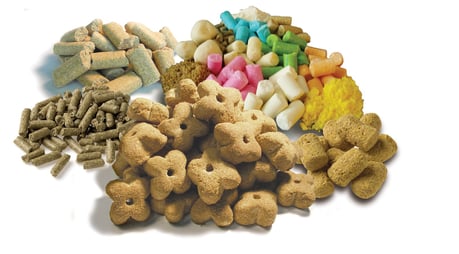Diet continues to be an overlooked variable in experimental investigations, impacting reproduction, growth, and disease, as well as affecting the response to experimental manipulation in laboratory animals.
Given that reproducibility is a key principle in the conduct and validation of experimental science, how can you ensure that your laboratory animal diet does not unduly influence your outcomes and conclusions drawn from your empirical data?
To answer this question, let’s discuss the function of a diet as a research tool and examine some of the key considerations in choosing the most optimal diet for your study’s needs.
 Understand the difference in diet types
Understand the difference in diet types
Diets can be categorized based on their ingredients:
- Natural: These ingredients are relatively unrefined agricultural commodities such as grains (corn, wheat, oats), grain by-products, plant-based proteins meals (soybeans, corn gluten, alfalfa) and animal-based proteins (pork, fish). These contain a variety of macro-, micro-, and non-nutrients and are considered chemically complex.
- Refined: Compared to natural ingredients, refined ingredients are chemically simple as the result of further processing from the source material, often removing non-nutrient components. The goal of a refined ingredient is often to provide one major nutrient and possibly trace amounts of other nutrients. Examples include casein, sucrose, glucose, fructose, and cornstarch, among others.
Laboratory animal diets are also categorized by their purpose:
- Standard (natural ingredient) diets: Also called grain-based or cereal-based, standard diets are a widely used type of laboratory animal diet, used to support reproduction, growth, and maintenance of animal colonies. Because of the nature of the ingredients and the scale of production, there will be a greater degree of nutrient variability relative to diets using refined ingredients. While this type of diet has been used in research for more than 75 years, the inherent presence of non-nutrients in these diets can impact phenotype.
- Custom diets: Also called purified, semi-purified, defined or synthetic, custom diets include highly-refined ingredients with simple chemical compositions, making it possible to manipulate individual nutrients. This level of control allows for more uniformity and reproducibility benefits as well as more versatility in diet design. Although less common, custom natural ingredient diets can be formulated using the same agricultural commodities found in standard diets. Whether controlling nutrient levels, inducing a disease state or dosing an animal, custom diets can serve a variety of purposes
- Medicated diets: Serving a veterinary purpose, these diets with added medications can supplement a standard diet to prevent or treat common infections (such as pinworms and fur mites) in laboratory animals.
The formulation of a diet matters as it could affect the interpretation of and confidence in the research results.
Open formula diets have published ingredient lists along with the recipe, while closed formula diets are proprietary, listing the ingredient composition but not the recipe. By definition, open formulas are fixed, meaning the same recipe is followed for each production. Closed formula diets can be either fixed or variable (the recipe can change over time).
While fixed formulas are unchanging, variable formulas can have shifting ingredient inclusion rates over time, in an effort to manage nutrient variability. However, end-users will not be aware if or how a formula like this changes over time.
Laboratory animal diet manufactures rely on stringent ingredient sourcing and manufacturing practices, for instance, purchasing ingredients only from approved suppliers and testing or inspecting the products before inclusion. The goal is to manage variability over a long period of time and achieve nutrient stability.
The value of minimizing non-nutrients
Study endpoints can be affected by the inclusion of non-nutrients in a diet, which may be inherent in the natural ingredient or present as a contaminant, such as arsenic, lead, mycotoxins or certain pesticides.
Several strategies can be employed to avoid these non-nutrients. Corn- and wheat-based ingredients can be screened for mycotoxins. Or a diet can exclude fish meal to minimize nitrosamines, a potential carcinogen, and lower arsenic levels. Excluding alfalfa meal greatly lowers background autofluorescence, which interferes with imaging in live animals.
As mentioned in a previous, the good, the bad and the ugly effects of dietary phytoestrogen in lab animal diets avoiding phytoestrogens, is a prime concern as they can mimic both the structure and the function of estrogen in mammals, leading to unpredictable effects and potentially unreliable results. Use of a standard diet that excludes soybean and alfalfa meals, or a purified diet, will help avoid any impact of dietary phytoestrogens.
Make an informed diet choice
Depending on your research needs, the following considerations can help you make informed decisions for your diet choice:
- Review the study vendor’s technical datasheet and ask a nutritionist to discuss nutrient levels
- Evaluate the list of ingredients to see if non-nutrients will affect your research
- Determine if the formulation approach matters, whether fixed or variable
- Research the diet manufacturer’s quality practices to ensure due diligence is conducted on their product
- Set aside time during experimental design planning to determine how diet may impact study conclusions
- Consider if a custom diet will best meet your research objectives by reviewing relevant literature and requesting a nutritionist consultation
Diet is a valuable research tool when chosen with intention. By understanding the potential variables with a diet, such as ingredients, nutrients, non-nutrients, formulation strategies, and manufacturing approaches, you will be better prepared to make more informed decisions.



